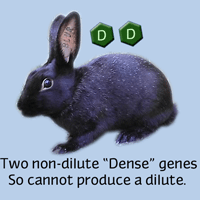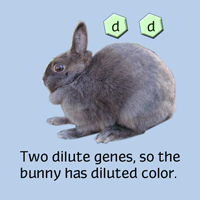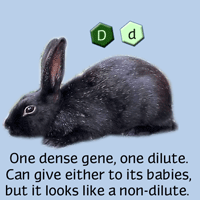A Simple Tutorial to Understanding Genetics in Rabbits
The life of a rabbit breeder — or a breeder of any animal from cattle to hamsters — is a constant struggle with genetics. They control everything about the physical aspects of our bunnies, from fur to color, to body type to health, even sometimes to traits like personality and mothering ability. Sometimes we can identify specific genes that are causing a trait, such as the Blue-eyed white gene. Other times we have a genetic problem like pinched hindquarters. Is there a “pinched hindquarters” gene and a “full hindquarters gene”? No, not exactly. So in trying to improve your herd, it’s important to keep only the best and healthiest, in hopes that the less-desirable traits will be bred out.
Most of the information available about rabbit genetics addresses coat color, because it’s easy to identify the specific genes that produce the different varieties. We write about genetics using symbols for each genes, and usually those symbols are letters of the alphabet. In rabbits, we use variations on the letters A, B, C, D, and E to indicate the main rabbit genes — isn’t that cool? Some of the genes change the color of the rabbit, such as black to chocolate, and others change how the colors are arranged, such as changing chestnut to otter.
How Rabbits Inherit Coat Color Genes from their Parents
It’s really quite simple. Each rabbit has two genes per “set” or locus. It got one from its dad and one from it’s mom. Likewise, when a rabbit becomes a parent, it has two possible genes per set to give its offspring. Sometimes it will give one and sometimes the other. This is how it works with all living things: humans to horses to hamsters. Like this…

Determining Your Rabbit’s Genotype
Within a set of genes there are at least two possibilities. For example, in the dilute series, there are only two options: the dilute gene and the non-dilute gene, which is sometimes called “dense”. Each rabbit has one or the other. In fact, each rabbit has two of one gene, or one of both. Like this:



Those pictures tell a lot right there.
Firstly, we use forms of the letter D as symbols for the dilute genes. “D” indicates the dense gene. “d” indicates the dilute gene. They’re just symbols, though, so we all know we’re talking about the same thing.
A rabbit’s genes written together is called a genotype. The genotypes in the examples above are DD, dd, and Dd. Technically there is a fourth possible genotype, dD. However, we usually write the bigger letter first, no matter which parent it came from. And there’s a very good reason for that…
Here’s the reason: We use the capital letter to indicate the more dominant gene. When a dominant gene is present with a lesser gene, like in the third picture above, the dominant gene shows and the lesser one remains hidden. It’s like a big man carrying a little one on his shoulders. You may not see the little man hiding up there, but he’s there none the less. If a rabbit is hiding a lesser gene– or a “recessive” gene — we say that the rabbit is “carrying” the lesser gene. The rabbit in the third picture is a black that carries blue, or a dense that carries dilute. More information on the dilute gene is available at this page.
When a rabbit shows a dominant gene but carries a recessive one, it often makes no difference in its appearance. You often don’t know that it is carrying a recessive gene without looking at the pedigree or breeding records. There are a few exceptions to this rule, however, such as the broken gene in rabbits. We use “En” to mean the broken or spotting gene in rabbits. EnEn is a charlie, enen is a solid, and Enen is a broken. You can get more information on the broken gene here.
How do you know if your rabbit is carrying or hiding any recessive genes?
Well, start by looking at the pedigree. A rabbit can only give what genes it has to its offspring. So if your black rabbit is directly out of a blue, you know it must carry the dilute gene, because the blue has only dilute genes to give.
Likewise, if your rabbit throws a dilute, it must carry the dilute gene, because a dilute rabbit has two “d” genes and got one from either parent. Obviously, we could go into a lot more detail about how to determine a rabbit’s color genotype, but it must be saved for another article! There are several pages dedicated to the topic in A book About Bunny Colors: The Practical Breeder’s Guide to Rabbit Coat Color.
In cases where we don’t know what the hidden gene is, we write a blank after the dominant gene, like this:. D_
When I breed my bunnies together, what will I get?
Again, it takes a knowledge of your rabbits’ genotypes, and therefore their pedigrees and breeding records, to accurately answer that question. There’s always surprises waiting for you, but even by looking at a rabbit’s appearance you can often predict the outcome of litters pretty closely — if you have the right knowledge. And that’s what this website is here to help you gather. Ready to jump in? Check out the next article: The Agouti Gene.
Breeding Squares, or Punnett Squares, is a valuable tool in predicting the genetic outcome of your matings. Visit this page to learn how to use Punnett Squares.
